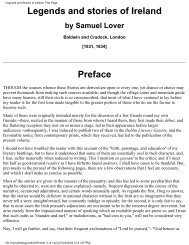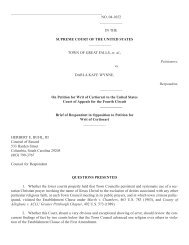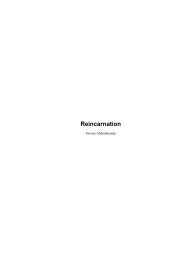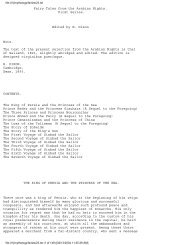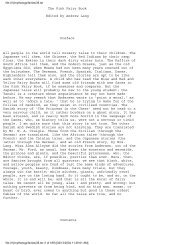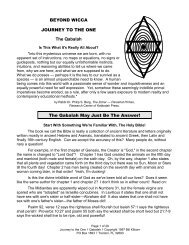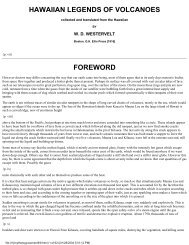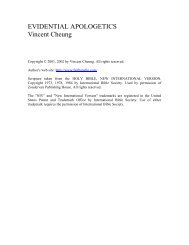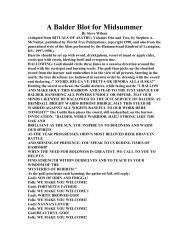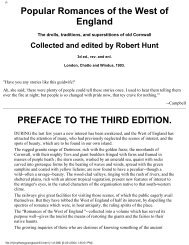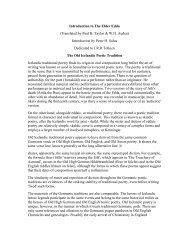You also want an ePaper? Increase the reach of your titles
YUMPU automatically turns print PDFs into web optimized ePapers that Google loves.
Lorsqu'on le rédigea sous sa forme actuelle, le règne de Mykérinos, et même celui d'Housapaiti, ne devaient pas soulever<br />
dans l'esprit des indigènes la sensation de l'archaïsme et du primitif: on avait pour rendre ces idées des expressions plus<br />
fortes, qui renvoyaient le lecteur au siècles des Serviteurs d'Horus, à la domination de Ra, aux âges où les dieux régnaient<br />
sur l'Égypte." Revue de l'Histoire des Religions, t. xv., p. 299.<br />
2 Chabas, Voyage, p. 46; Wiedemann, Aegyptische Geschichte, p. 191. In the Brit. Mus. papyrus No. 10,060 (Harris 500),<br />
Herutataf is mentioned together with I-em-hetep as a well known author, and the writer of the dirge says, "I have heard the<br />
words of I-em-hetep and of Herutataf, whose many and varied writings are said and sung; but now where are their places?"<br />
The hieratic text is published with a hieroglyphic transcript by Maspero in Journal Asiatique, Sér. VII ième , t. xv., p. 404 ff.,<br />
and Études Égyptiennes, t. i., p. 173; for English translations, see Trans. Soc. Bibl. Arch., vol. iii., p. 386, and Records of<br />
the Past, 1st ed., vol. iv., p. 117.<br />
3 According to the Westcar papyrus, Herutataf informed his father Khufu of the existence of a man 110 years old who<br />
lived in the town of Tettet-Seneferu: he was able to join to its body again a head that had been cut off, and possessed<br />
influence over the lion, and was acquainted with the mysteries of Thoth. By Khufu's command Herutataf brought the sage<br />
to him by boat, and, on his arrival, the king ordered the head to be struck off from a prisoner that Tetteta might fasten it on<br />
again. Having excused himself from performing this act upon a man, a goose was brought and its head was cut off and laid<br />
on one side of the room and the body was placed on the other. The sage spake certain words of power whereupon the<br />
goose stood up and began to waddle, and the head also began to move towards it; when the head had joined itself again to<br />
the body the bird stood up and cackled. For the complete hieratic text, transcript and translation, see Erman, Die Märchen<br />
des Papyrus Westcar, Berlin, 1890, p. it, plate 6.]<br />
{p. xvi}<br />
The Book of the Dead in the IInd dynasty.<br />
Passing from the region of native Egyptian tradition, we touch firm ground with the evidence derived<br />
from the monuments of the IInd dynasty. A bas-relief preserved at Aix in Provence mentions Âasen and<br />
Ankef,[1] two of the priests of Sent or Senta, the fifth king of the IInd dynasty, about B.C. 4000; and a<br />
stele at Oxford[2] and another in the Egyptian Museum at Gizeh[3] record the name of a third priest,<br />
Shera or Sheri, a "royal relative" On the stele at Oxford we have represented the deceased and his wife<br />
seated, one on each side of an altar,[4] which is covered with funeral offerings of pious relatives; above,<br />
in perpendicular lines of hieroglyphics in relief, are the names of the objects offered,[5] and below is an<br />
inscription which reads,[6] "thousands of loaves of bread, thousands of vases of ale, thousands of linen<br />
garments, thousands of changes of wearing apparel, and thousands of oxen." Now from this monument it<br />
is evident that already in the IInd dynasty a priesthood existed in Egypt which numbered among its<br />
members relatives of the royal family, and that a religious system which prescribed as a duty the<br />
providing of meat and drink offerings for the dead was also in active operation. The offering of specific<br />
objects goes far to prove the existence of a ritual or service wherein their signification would be<br />
indicated; the coincidence of these words and the prayer for "thousands of loaves of bread, thousands of<br />
vases of ale," etc., with the promise, "Anpu-khent-Amenta shall give thee thy thousands of loaves of<br />
bread, thy thousands of vases of ale, thy thousands of vessels<br />
[1. Wiedemann, Aegyptische Geschichte, p. 170. In a mastaba at Sakkara we have a stele of Sheri, a superintendent of the<br />
priests of the ka, whereon the cartouches of Sent and Per-ab-sen both occur. See Mariette and Maspero, Les Mastaba de<br />
l'ancien Empire, Paris, 1882, p. 92.<br />
2. See Lepsius, Auswahl, Bl. 9.<br />
3. See Maspero, Guide du Visiteur au Musée de Boulaq, 1883, pp. 31, 32, and 213 (No. 1027).<br />
4 A discussion on the method of depicting this altar on Egyptian monuments by Borchardt may be found in Aeg.<br />
Zeitschrift, Bd. XXXI., p. i (Die Darstellung innen verzierter Schalen auf aeg. Denkmälern).<br />
file:///I|/mythology/egypt/1/1.html (8 of 189) [01/25/2004 3:29:57 PM]



